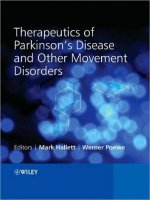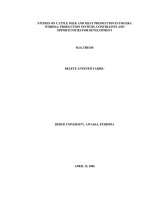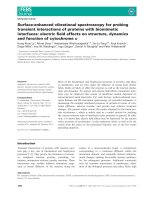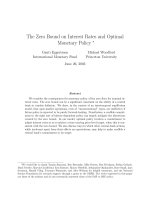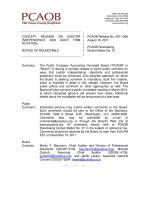Milk Thistle: Effects on Liver Disease and Cirrhosis and Clinical Adverse Effects doc
Bạn đang xem bản rút gọn của tài liệu. Xem và tải ngay bản đầy đủ của tài liệu tại đây (2.65 MB, 158 trang )
Evidence Report/Technology Assessment
Number 21
Milk Thistle: Effects on
Liver Disease and
Cirrhosis and Clinical
Adverse Effects
Agency for Healthcare Research and Quality
On December 6, 1999, under Public Law 106-129, the Agency for Health Care Policy and
Research (AHCPR) was reauthorized and renamed the Agency for Healthcare Research and
Quality (AHRQ). The law authorizes AHRQ to continue its research on the cost, quality, and
outcomes of health care and expands its role to improve patient safety and address medical
errors.
This report may be used, in whole or in part, as the basis for development of clinical practice
guidelines and other quality enhancement tools, or a basis for reimbursement and coverage
policies. AHRQ or U.S. Department of Health and Human Services endorsement of such
derivative products may not be stated or implied.
Evidence Report/Technology Assessment
Number 21
Milk Thistle: Effects on Liver Disease
and Cirrhosis and Clinical Adverse
Effects
Prepared for:
Agency for Healthcare Research and Quality
U.S. Department of Health and Human Services
2101 East Jefferson Street
Rockville, MD 20852
Contract No. 290-97-0012
Prepared by:
San Antonio Evidence-based Practice Center based at The University of Texas Health Science Center
at San Antonio and The Veterans Evidence-based Research, Dissemination, and Implementation
Center, a Veterans Affairs Health Services Research and Development Center of Excellence
Cynthia Mulrow, MD, MSc
Program Director
Valerie Lawrence, MD, MSc
Principal Investigator
Bradly Jacobs, MD, MPH
Cathi Dennehy, PharmD
Jodi Sapp, RN
Gilbert Ramirez, DrPH
Christine Aguilar, MD, MPH
Kelly Montgomery, MPH
Laura Morbidoni, MD
Jennifer Moore Arterburn, MTSC
Elaine Chiquette, PharmD
Martha Harris, MLS, MA
David Mullins
Andrew Vickers, MD
Kenneth Flora, MD, FACG
AHRQ Publication No. 01-E025
October 2000
iii
Preface
The Agency for Healthcare Research and Quality (AHRQ), formerly the Agency for Health
Care Policy and Research, through its Evidence-based Practice Centers (EPCs), sponsors the
development of evidence reports and technology assessments to assist public and private-sector
organizations in their efforts to improve the quality of health care in the United States. The
reports and assessments provide organizations with comprehensive, science-based information
on common, costly medical conditions and new health care technologies. The EPCs
systematically review the relevant scientific literature on topics assigned to them by AHRQ and
conduct additional analyses when appropriate prior to developing their reports and assessments.
To bring the broadest range of experts into the development of evidence reports and health
technology assessments, AHRQ encourages the EPCs to form partnerships and enter into
collaborations with other medical and research organizations. The EPCs work with these partner
organizations to ensure that the evidence reports and technology assessments they produce will
become building blocks for health care quality improvement projects throughout the Nation. The
reports undergo peer review prior to their release.
AHRQ expects that the EPC evidence reports and technology assessments will inform
individual health plans, providers, and purchasers as well as the health care system as a whole by
providing important information to help improve health care quality.
We welcome written comments on this evidence report. They may be sent to: Director,
Center for Practice and Technology Assessment, Agency for Healthcare Research and Quality,
6010 Executive Blvd., Suite 300, Rockville, MD 20852.
John M. Eisenberg, M.D. Douglas B. Kamerow, M.D.
Director Director, Center for Practice and Technology
Agency for Healthcare Research Assessment
and Quality Agency for Healthcare Research and Quality
The authors of this report are responsible for its content. Statements in the report should not be
construed as endorsement by the Agency for Healthcare Research and Quality or the U.S.
Department of Health and Human Services of a particular drug, test, treatment, or other clinical
service.
iv
v
Structured Abstract
Objectives. This evidence report summarizes studies of efficacy and adverse effects of milk
thistle in humans with alcohol, viral, or toxin-related liver disease.
Search Strategy. English and non-English citations were identified through December 1999
from 11 electronic databases, references of pertinent articles and reviews, manufacturers, and
technical experts.
Selection Criteria. Selection criteria regarding efficacy were placebo-controlled trials of milk
thistle. For adverse effects, all studies in humans were used.
Data Collection and Analysis. Abstractors independently abstracted data from published
reports. Relationships between clinical outcomes and methodologic characteristics were
examined in evidence tables and graphic summaries. Exploratory meta-analyses were used to
examine possible patterns of effects.
Main Results.
• Sixteen prospective placebo-controlled trials were identified.
• Interpreting the evidence was difficult because of inadequate reporting and study design
regarding severity of liver disease, subject characteristics, and potential confounders.
Outcome measures, dose, duration, and followup widely varied among studies.
• Four of six studies of chronic alcoholic liver disease reported significant improvement in at
least one parameter of liver function or histology with milk thistle.
• In three of six studies that reported multiple outcome measures, at least one outcome measure
improved significantly with milk thistle compared with placebo, but there were no
differences between milk thistle and placebo for one or more of the other outcome measures
in each study.
• Three studies evaluated the effects of milk thistle on viral hepatitis. The acute hepatitis study
showed no improvement in liver function. Improvement in aspartate aminotransferase and
bilirubin was significant in the study of acute hepatitis. Two studies of chronic viral hepatitis
showed improvement in aminotransferases with milk thistle in one and a trend toward
histologic improvement in the other.
• There were two studies of patients with alcoholic or nonalcoholic cirrhosis. In one study,
milk thistle showed a positive effect, but no data were given. In the other, milk thistle
showed a trend toward improved survival and significantly improved survival for subgroups
with alcoholic cirrhosis or Child’s Group A severity.
• Two trials specifically studied alcoholic cirrhosis. One showed no improvement in liver
function, hepatomegaly, jaundice, ascites, or survival but did show nonsignificant trends
vi
favoring milk thistle in the incidence of encephalopathy, gastrointestinal bleeding, and death
in subjects with hepatitis C. The other reported significant improvements in
aminotransferases with milk thistle.
• Three trials evaluated thistle as therapy or prophylaxis in the setting of hepatotoxic drugs;
results were mixed.
• Meta-analyses generally showed small effect sizes, some statistically significant and some
not, favoring milk thistle.
• Available evidence does not define milk thistle’s effectiveness across preparations or doses.
• Little evidence is available regarding causality, but evidence suggests milk thistle is
associated with few, generally minor, adverse effects.
Conclusions. Milk thistle’s efficacy is not established. Published evidence is clouded by poor
design and reporting. Possible benefit has been shown most frequently, but inconsistently, for
aminotransferases, but laboratory tests are the most common outcome measure studied. Survival
and other clinical outcomes have been studied less, with mixed results. Future research should
include definition of multifactorial mechanisms of action, well-designed clinical trials, and
clarification of adverse effects.
This document is in the public domain and may be used and reprinted without permission except
those copyrighted materials noted for which further reproduction is prohibited without the
specific permission of copyright holders.
Suggested Citation:
Mulrow C, Lawrence V, Jacobs B, et al. Milk thistle: effects on liver disease and cirrhosis and
clinical adverse effects. Evidence Report/Technology Assessment No. 21 (Contract 290-97-
0012 to the San Antonio Evidence-based Practice Center, based at the University of Texas
Health Science Center at San Antonio, and The Veterans Evidence-based Research,
Dissemination, and Implementation Center, a Veterans Affairs Services Research and
Development Center of Excellence). AHRQ Publication No. 01-E025. Rockville, MD: Agency
for Healthcare Research and Quality. October 2000.
Contents
Summary 1
EVIDENCE REPORT
Chapter 1. Introduction 9
Scope and Objectives 9
Effects of Milk Thistle on Hepatic Disease 9
Clinical Adverse Effects of Milk Thistle 9
Background 9
The Plant 11
Historical Uses of Milk Thistle 11
The Milk Thistle Industry 12
Chemistry and Pharmacokinetics of Milk Thistle 13
Mechanisms of Milk Thistle 14
Antioxidant Activity 14
Toxin Blockade 15
Enhanced Protein Synthesis 15
Antifibrotic Activity 15
Other Postulated Mechanisms 16
Current Preparations of Milk Thistle 16
Challenges in Interpreting the Evidence 16
Chapter 2. Methodology 17
Expert Input 17
Questions Addressed in Evidence Report 17
Literature Search and Selection Methods 19
Sources and Search Methods 19
Selection Processes 19
Data Abstraction Process 22
Unpublished Data 22
Data Analysis Process 22
Exploratory Meta-Analysis 23
Chapter 3. Results 25
Overview of the Evidence 25
Milk Thistle Preparations and Doses 25
Milk Thistle and Liver Disease 27
Milk Thistle and Alcohol-Related Liver Disease 27
Milk Thistle and Chronic Liver Disease of Mixed Etiology 27
Milk Thistle and Viral Liver Disease 28
Milk Thistle and Cirrhosis 28
Milk Thistle and Toxin-Induced Liver Disease 29
Milk Thistle and Cholestasis 30
Milk Thistle and Primary Hepatic Malignancy 30
Effectiveness of Different Preparations of Milk Thistle 30
Exploratory Meta-Analyses Results 31
vii
Adverse Effects of Milk Thistle 38
Overview of Adverse Effect Literature 38
Common Symptomatic Effects 38
Common and Uncommon Serious Adverse Effects 38
Chapter 4. Conclusions 41
Chapter 5. Future Research 43
Adverse Effects 43
Beneficial Effects Regarding Liver Diseases 43
Specific Areas of Research 43
References 45
Summary Tables 53
Evidence Tables 73
Bibliography 99
Appendix A. Milk Thistle Search Strategies 113
Appendix B. Graphic Summaries 115
Appendix C. Contributors 143
Appendix D. Acronyms 149
viii
Appendix C. Contributors
We owe a major debt of gratitude to the following groups of multidisciplinary experts from
around the world who assisted in preparing this report: 10 national advisory panel members, 3
technical experts who helped define the scope and shape the content, 14 peer reviewers
representing a variety of backgrounds and viewpoints, and 5 scientific authors who provided
additional data from their studies.
National Advisory Panel
Marilyn Barrett, PhD
Owner and Principal
Pharmacognosy Consulting Services
Mark Blumenthal
Executive Director
American Botanical Council
David Eisenberg, MD
Beth Israel Deaconess Medical Center
Lucinda Miller, PharmD, BCPS
Editor
Journal of Herbal Pharmacotherapy
Richard Nahin, MPH, PhD
Acting Director
Division of Extramural Research
National Center for Complementary and Alternative Medicine
Mary Ann Richardson, DrPH
Assistant Professor and Director
The University of Texas Center for Alternative Medicine Research in Cancer
The University of Texas - Houston Health Science Center School of Public Health
Nancy Ridenour, RN, PhD, CS, FNC, FAAN
Dean
College of Nursing
Illinois State University
David Schardt
Associate Nutritionist
Center for Science in the Public Interest
143
William A. Watson, PharmD, DABAT, FAACT
Professor (Clinical) and Managing Director
Department of Surgery
South Texas Poison Center
The University of Texas Health Science Center at San Antonio
Elizabeth Yetley, PhD
Director
Office of Special Nutritionals
Center for Food Safety and Applied Nutrition
Food and Drug Administration
Technical Experts
Bradly Jacobs, MD, MPH
Senior Clinical Research Fellow
Osher Center for Integrative Medicine
Department of Medicine
University of California - San Francisco/Veterans Affairs Medical Center
Cathi Dennehy, PharmD
Assistant Clinical Professor
University of California at San Francisco
Kenneth Flora, MD, FACG
Assistant Professor
Oregon Health Sciences University
Peer Reviewers
Fourteen peer reviewers provided insightful comments and feedback on our draft report.
Maurizio Bonacini, MD
Associate Professor
Hepatitis Research Center
Division of Gastroenterology and Liver Diseases
Department of Medicine
University of Southern California School of Medicine
Robert Eckel, MD
Professor
Division of Endocrinology, Metabolism, and Diabetes
Department of Medicine
University of Colorado Health Science Center
144
Wolfgang Fleig, MD
Professor and Chair
First Department of Medicine
Martin Luther University Halle-Wittenberg
Halle (Saale), Germany
Robert Fontana, MD
Assistant Professor
Department of Internal Medicine
University of Michigan Health System
Alexander Gerbes, MD
Professor
Ludwig-Maximilians-Universitat-München
Eric Gershwin, MD
Division Chief
Division of Rheumatology/Allergy
Department of Internal Medicine
University of California at Davis School of Medicine
Ruth Kava, PhD, RD
Director of Nutrition
American Council on Science and Health
Ronald Koretz, MD
Professor and Chief
Division of Gastroenterology
Department of Medicine
University of California at Los Angeles
David Lee, PhD
Director
Natural Products Laboratory
McLean Hospital
Klaus Linde, MD
Researcher
Centre for Complementary Medicine Research
Department of Internal Medicine II Technichal University
Tianshu Liu, MD, MSc
Attending Physician
Department of Gastroenterology
Shanghai Medical University
Zhoug Medical Hospital
145
Srini Srinivasan, PhD
Director
Dietary Supplements Division
U.S. Pharmacopoeia
Kathleen Stevens, RN, EdD, FAAN
Professor
Department of Family Nursing
The University of Texas Health Science Center at San Antonio
Wendell Winters, PhD
Associate Professor
Department of Microbiology
The University of Texas Health Science Center at San Antonio
Authors Who Provided Additional Data
Some articles included in this report had relevant data missing from their publications. We
contacted the authors requesting this information. Our heartfelt thanks to those who responded:
Dr. Paolo Saba
Dr. Heikki A. Salmi
Dr. Gianluigi Vendemiale
Dr. Peter Ferenci
Dr. Robert Flisiak
San Antonio Evidence-based Practice Center and Veterans
Evidence-based Research, Dissemination and
Implementation Center Staff
Project Leaders
Cynthia Mulrow, MD, MSc
Program Director
Valerie Lawrence, MD, MSc
Principal Investigator
146
Project Investigators
Valerie Lawrence, MD, MSc
Cynthia Mulrow, MD, MSc
Bradly Jacobs, MD, MPH
Cathi Dennehy, PharmD
Jodi Sapp, RN
Christine Aguilar, MD, MPH
Kelly Montgomery, MPH
Laura Morbidoni, MD
Elaine Chiquette, PharmD
Kenneth Flora, MD, FACG
Meta-Analysts
Gilbert Ramirez, DrPH
John E. Cornell, PhD
Information Specialists
Andrew Vickers, MD
Martha Harris, MLS, MA
Technical Writer and Peer Review Coordinator
Jennifer Moore Arterburn, MTSC
Computer Resources
David Mullins
Administration
Annie Almanza
Sheryl Moore
Linn Morgan
147
Summary
Overview
This evidence report details a systematic review summarizing clinical studies of milk thistle
in humans. The scientific name for milk thistle is Silybum marianum. It is a member of the
aster or daisy family and has been used by ancient physicians and herbalists to treat a range of
liver and gallbladder diseases and to protect the liver against a variety of poisons. Two areas are
addressed in the report: (1) effects of milk thistle on liver disease of alcohol, viral, toxin,
cholestatic, and primary malignancy etiologies; and (2) clinical adverse effects associated with
milk thistle ingestion or contact. The report was requested by the National Center for
Complementary and Alternative Medicine, a component of the National Institutes of Health, and
sponsored by the Agency for Healthcare Research and Quality (AHRQ).
Reporting the Evidence
Specifically, the report addresses 10 questions regarding whether milk thistle supplements—
compared with no supplement, placebo, other oral supplements, or drugs—alter the physiological
markers of liver function, reduce mortality or morbidity, or improve the quality of life in adults
with alcohol-related, toxin-induced, or drug-induced liver disease, viral hepatitis, cholestasis, or
primary hepatic malignancy. One question addresses the constituents of commonly available
milk thistle preparations, and three questions address the common and uncommon symptomatic
adverse effects of milk thistle.
Methodology
Search Strategy
Eleven electronic databases, including AMED, CISCOM, and the Cochrane Library
(including DARE and the Cochrane Controlled Trials Registry), EMBASE, MEDLINE, and
NAPRALERT, were searched through July 1999 using the following terms: carduus marianus,
legalon, mariendistel, milk thistle, silybin, silybum marianum, silybum, silychristin, silydianin,
and silymarin. An update search limited to PubMed was conducted in December 1999. English
and non-English citations were identified from these electronic databases, references in pertinent
articles and reviews, drug manufacturers, and technical experts.
Selection Criteria
Preliminary selection criteria regarding efficacy were reports on liver disease and clinical and
physiologic outcomes from randomized controlled trials (RCTs) in humans comparing milk
thistle with placebo, no milk thistle, or another active agent. Several of these randomized trials
had dissimilar numbers of subjects in study arms, raising the question that these were not
actually RCTs but cohort studies. In addition, among studies using nonplacebo controls, the type
of control varied widely. Therefore, qualitative and quantitative syntheses of data on
1
effectiveness were limited to placebo-controlled studies. For adverse effects, all types of studies
in humans were used to assess adverse clinical effects.
Data Collection and Analysis
Abstractors (physicians, methodologists, pharmacists, and a nurse) independently abstracted
data from trials; a nurse and physician abstracted data about adverse effects. Data were
synthesized descriptively, emphasizing methodologic characteristics of the studies, such as
populations enrolled, definitions of selection and outcome criteria, sample sizes, adequacy of
randomization process, interventions and comparisons, cointerventions, biases in outcome
assessment, and study designs. Evidence tables and graphic summaries, such as funnel plots,
Galbraith plots, and forest plots, were used to examine relationships between clinical outcomes,
participant characteristics, and methodologic characteristics. Trial outcomes were examined
quantitatively in exploratory meta-analyses that used standardized mean differences between
mean change scores as the effect size measure.
Findings
Mechanisms of Action
Evidence exists that milk thistle may be hepatoprotective through a number of mechanisms:
antioxidant activity, toxin blockade at the membrane level, enhanced protein synthesis,
antifibriotic activity, and possible anti-inflammatory or immunomodulating effects.
Preparations of Milk Thistle
The largest producer of milk thistle is Madaus (Germany), which makes an extract of
concentrated silymarin. However, numerous other extracts exist, and more information is
needed on comparability of formulations, standardization, and bioavailability for studies of
mechanisms of action and clinical trials.
Benefit of Milk Thistle for Liver Disease
• Sixteen prospective trials were identified. Fourteen were randomized, blinded, placebo-
controlled studies of milk thistle’s effectiveness in a variety of liver diseases. In one
additional placebo-controlled trial, blinding or randomization was not clear, and one placebo-
controlled study was a cohort study with a placebo comparison group.
• Seventeen additional trials used nonplacebo controls; two other trials studied milk thistle as
prophylaxis in patients with no known liver disease who were starting potentially hepatotoxic
drugs. The identified studies addressed alcohol-related liver disease, toxin-induced liver
disease, and viral liver disease. No studies were found that evaluated milk thistle for
cholestatic liver disease or primary hepatic malignancy (hepatocellular carcinoma,
cholangiocarcinoma).
2
• There were problems in assessing the evidence because of incomplete information about
multiple methodologic issues, including etiology and severity of liver disease, study design,
subject characteristics, and potential confounders. It is difficult to say if the lack of
information reflects poor scientific quality of study methods or poor reporting quality or
both.
• Detailed data evaluation and syntheses were limited to the 16 placebo-controlled studies.
Distribution of durations of therapy across trials was wide (7 days to 2 years), inconsistent,
and sometimes not given. Eleven studies used Legalon
®
, and eight of those used the same
dose. Outcome measures varied among studies, as did duration of therapy and the followup
for which outcome measures were reported.
• Among six studies of milk thistle and chronic alcoholic liver disease, four reported
significant improvement in at least one measurement of liver function (i.e.,
aminotransferases, albumin, and/or malondialdehyde) or histologic findings with milk thistle
compared with placebo, but also reported no difference between groups for other outcome
measures.
• Available data were insufficient to sort six studies into specific etiologic categories; these
were grouped as chronic liver disease of mixed etiologies. In three of the six studies that
reported multiple outcome measures, at least one outcome measure improved significantly
with milk thistle compared with placebo, but there were no differences between milk thistle
and placebo for one or more of the other outcome measures in each study. Two studies
indicated a possible survival benefit.
• Three placebo-controlled studies evaluated milk thistle for viral hepatitis. The one acute
viral hepatitis study reported latest outcome measures at 28 days and showed significant
improvement in aspartate aminotransferase and bilirubin. The two studies of chronic viral
hepatitis differed markedly in duration of therapy (7 days and 1 year). The shorter study
showed improvement in aminotransferases for milk thistle compared with placebo but not
other laboratory measures. In the longer study, milk thistle was associated with a
nonsignificant trend toward histologic improvement, the only outcome measure reported.
• Two trials included patients with alcoholic or nonalcoholic cirrhosis. The milk thistle arms
showed a trend toward improved survival in one trial and significantly improved survival for
subgroups with alcoholic cirrhosis or Child’s Group A severity. The second study reported
no significant improvement in laboratory measures and survival for other clinical subgroups,
but no data were given.
• Two trials specifically studied patients with alcoholic cirrhosis. Duration of therapy was
unclear in the first, which reported no improvement in laboratory measures of liver function,
hepatomegaly, jaundice, ascites, or survival. However, there were nonsignificant trends
favoring milk thistle in incidence of encephalopathy and gastrointestinal bleeding and in
survival for subjects with concomitant hepatitis C. The second study, after treatment for 30
days, reported significant improvements in aminotransferases but not bilirubin for milk
thistle compared with placebo.
3
• Three trials evaluated milk thistle in the setting of hepatotoxic drugs: one for therapeutic use
and two for prophylaxis with milk thistle. Results were mixed among the three trials.
• Exploratory meta-analyses generally showed positive but small and nonsignificant effect
sizes and a sprinkling of significant positive effects.
• No studies were identified regarding milk thistle and cholestatic liver disease or primary
hepatic malignancy.
• Available evidence does not establish whether effectiveness of milk thistle varies across
preparations. One Phase II trial suggested that effectiveness may vary with dose of milk
thistle.
Adverse Effects
Adverse effects associated with oral ingestion of milk thistle include gastrointestinal
problems (e.g., nausea, diarrhea, dyspepsia, flatulence, abdominal bloating, abdominal fullness
or pain, anorexia, and changes in bowel habits), headache, skin reactions (pruritus, rash,
urticaria, and eczema), neuropsychological events (e.g., asthenia, malaise, and insomnia),
arthralgia, rhinoconjunctivitis, impotence, and anaphylaxis. However, causality is rarely
addressed in available reports. For randomized trials reporting adverse effects, incidence was
approximately equal in milk thistle and control groups.
Conclusions
Clinical efficacy of milk thistle is not clearly established. Interpretation of the evidence is
hampered by poor study methods and/or poor quality of reporting in publications. Problems in
study design include heterogeneity in etiology and extent of liver disease, small sample sizes,
and variation in formulation, dosing, and duration of milk thistle therapy. Possible benefit has
been shown most frequently, but not consistently, for improvement in aminotransferases and
liver function tests are overwhelmingly the most common outcome measure studied. Survival
and other clinical outcome measures have been studied least often, with both positive and
negative findings. Available evidence is not sufficient to suggest whether milk thistle may be
more effective for some liver diseases than others or if effectiveness might be related to duration
of therapy or chronicity and severity of liver disease. Regarding adverse effects, little evidence
is available regarding causality, but available evidence does suggest that milk thistle is associated
with few, and generally minor, adverse effects.
Despite substantial in vitro and animal research, the mechanism of action of milk thistle is
not fully defined and may be multifactorial. A systematic review of this evidence to clarify what
is known and identify gaps in knowledge would be important to guide design of future studies of
the mechanisms of milk thistle and clinical trials.
4
Future Research
The type, frequency, and severity of adverse effects related to milk thistle preparations
should be quantified. Whether adverse effects are specific to dose, particular preparations, or
additional herbal ingredients needs elucidation, especially in light of equivalent frequencies of
adverse effects in available randomized trials. When adverse effects are reported, concomitant
use of other medications and product content analysis should also be reported so that other drugs,
excipients, or contaminants may be scrutinized as potential causal factors.
Characteristics of future studies in humans should include longer and larger randomized
trials; clinical as well as physiologic outcome measures; histologic outcomes; adequate blinding;
detailed data about compliance and dropouts; systematic standardized surveillance for adverse
effects; and attention to specific study populations (e.g., patients with hepatitis B virus [HBV], or
hepatitis C virus [HCV], or mixed infection or coinfection with human immunodeficiency virus
[HIV]), comorbidities, alcohol consumption, and potential confounders. There also should be
detailed attention to preparation, standardization, and bioavailability of different formulations of
milk thistle (e.g., standardized silymarin extract and silybin-phosphatidylcholine complex).
Precise mechanisms of action specific to different etiologies and stages of liver disease need
explication. Further mechanistic investigations are needed and should be considered before, or
in concert with, studies of clinical effectiveness. More information is needed about effectiveness
of milk thistle for severe acute ingestion of hepatotoxins, such as occupational exposures,
acetaminophen overdose, and amanita poisoning.
5
Chapter 1. Introduction
Scope and Objectives
This evidence report about milk thistle was requested by the National Center for
Complementary and Alternative Medicine, a component of the National Institutes of Health, and
was contracted by the Agency for Healthcare Research and Quality. This chapter highlights the
history of milk thistle, its chemistry, recent research, the variety in available commercial
preparations, and challenges in conducting research and interpreting the evidence in humans.
The evidence report is a systematic review that summarizes studies in humans that address the
effects of milk thistle in treating liver disease of alcohol, viral, toxin, cholestatic, and primary
malignancy etiologies. Figure 1 shows the evidence model, which was formulated by the
national advisory and technical expert panels that guided the review.
Effects of Milk Thistle on Hepatic Disease
Results of trials comparing milk thistle preparations with placebo or other agents are
presented. A formal summary of the evidence uses only available placebo controlled trials.
Effects on the following outcomes are addressed: laboratory tests, histologic findings,
morbidity, and mortality.
Clinical Adverse Effects of Milk Thistle
Various reported adverse effects, including dermatologic, gastrointestinal, and anaphylactoid
reactions, are summarized.
Background
Milk thistle has been used since the time of ancient physicians and herbalists to treat a range
of liver and gallbladder disorders, including hepatitis, cirrhosis, and jaundice, and to protect the
liver against poisoning from chemical and environmental toxins, including snake bites, insect
stings, mushroom poisoning, and alcohol.
Milk thistle’s history begins with its name. The scientific name for milk thistle is Silybum
marianum: “Silybum” is the name Dioscorides gave to edible thistles,
1
and “marianum” comes
from the legend that the white veins running through the plant’s leaves were caused by a drop of
the Virgin Mary’s milk.
1-4
While looking for a place to nurse the infant Jesus when leaving
Egypt, Mary could only find shelter in a bower formed by the thorny leaves of the milk thistle.
5
From this story was born the folk belief that the plant was good for nursing mothers.
6
Other
names that have been attributed to milk thistle include Marian thistle, Mary thistle, St. Mary’s
thistle, Lady’s thistle, Holy thistle, sow thistle, thistle of the blessed virgin, Christ’s crown,
Venus thistle, heal thistle, variegated thistle, and wild artichoke.
Milk thistle is a member of the aster or daisy family (Asteracae), which includes, in addition
to asters and daisies, a host of other thistles and the artichoke.
7
Milk thistle is one of the most
important medical members of this genus.
8
9
Figure 1. Evidence model: Milk thistle and liver disease
10
The Plant
Milk thistle is a tall plant that can grow up to 10 feet with thorny stems, dark glossy green
leaves, and milky-white veins running throughout. Its most distinguishing feature is the large,
bright purple flower sprouting at the top.
3,7,8
Historical Uses of Milk Thistle
For centuries, nearly every part of the plant—from root to hull—has been used in some
way.
4,6
In her famous book, Maud Grieve explained several ways the milk thistle can be eaten,
including the heads like an artichoke, raw stalks (which are considered palatable and nutritious),
and the leaves as a salad.
8
She also quoted Bryant, who wrote in his Flora Dietetica, “The
young shoots in the Spring, cut close to the root with part of the stalk on, is one of the best
boiling salads that is eaten, and surpasses the finest cabbage. They were sometimes baked in
pies. The roots may be eaten like those of Salsify.”
8
Milk thistle has also historically been used for animal feed. Grieve wrote that in parts of
England, the leaves are called “pig leaves” because pigs liked them; also, the seeds are a favorite
food of goldfinches.
8
In Scotland, the leaves were used extensively as food for cattle and horses
(the leaves were beaten and crushed to rid them of prickles) before the introduction of special
green crops.
8
The milk thistle prickles have also been used historically as a substitute for barbed
wire.
9
Despite this wide spectrum of perceived value, farmers considered it and other thistles a
sign of untidiness and neglect.
8
Most sources on milk thistle, which is native to southern Europe (specifically Mediterranean
areas) and Asia,
5
put its beginning at 2,000 years ago.
1,2,6,9
One of the earliest mentions of
thistles in general is in the Bible (Genesis 3:18). In this verse, God told Adam and Eve when
they were banished from the Garden of Eden that “thorns also and thistles shall it bring forth to
thee.”
Some of the earliest people to use and write about milk thistle were ancient Greek and
Roman physicians and herbalists, each of whom seemed to have their own name for the herb.
Dioscorides called it “sillybon,” Pliny the Elder called it “sillybum,” and Theophrastus called it
“pternix.”
5
Dioscorides’ use of milk thistle is one of the oldest known references to the
medicinal use of this plant. He suggested preparing it in a tea “for those that be bitten of
serpents.”
10
Another famous ancient herbalist, Pliny the Elder, wrote that mixing the juice of the
plant with honey was good for “carrying off bile.”
1,9
Milk thistle is mentioned in several works from the Middle Ages, one of the first being in a
record of old Saxon remedies, which claimed that “this wort if hung upon a man’s neck it setteth
snakes to flight.”
8
One of the best known herbalists from this time, John Gerard (1545-1612),
recommended milk thistle for expelling melancholy and its related diseases (melancholy diseases
were described in medicine in the Middle Ages as related to the liver and also called “black
bile”).
8-10
Another well known English herbalist, Nicholas Culpeper (1616-54), recommended
milk thistle for several maladies: breaking and expelling stones, removing obstructions of the
liver and spleen, treating jaundice and infections of the plague, and cleansing the blood.
8,9
Maud Grieve, who compiled her book of herbal information in 1931, quoted several early
English herbalists on their love for and use of milk thistle. She reports that in 1694 Westmacott
wrote of milk thistle, “It is a friend to the liver and blood: the prickles cut off, they were
formerly used to be boiled in the spring and eaten with other herbs; but as the World decays, so
11
